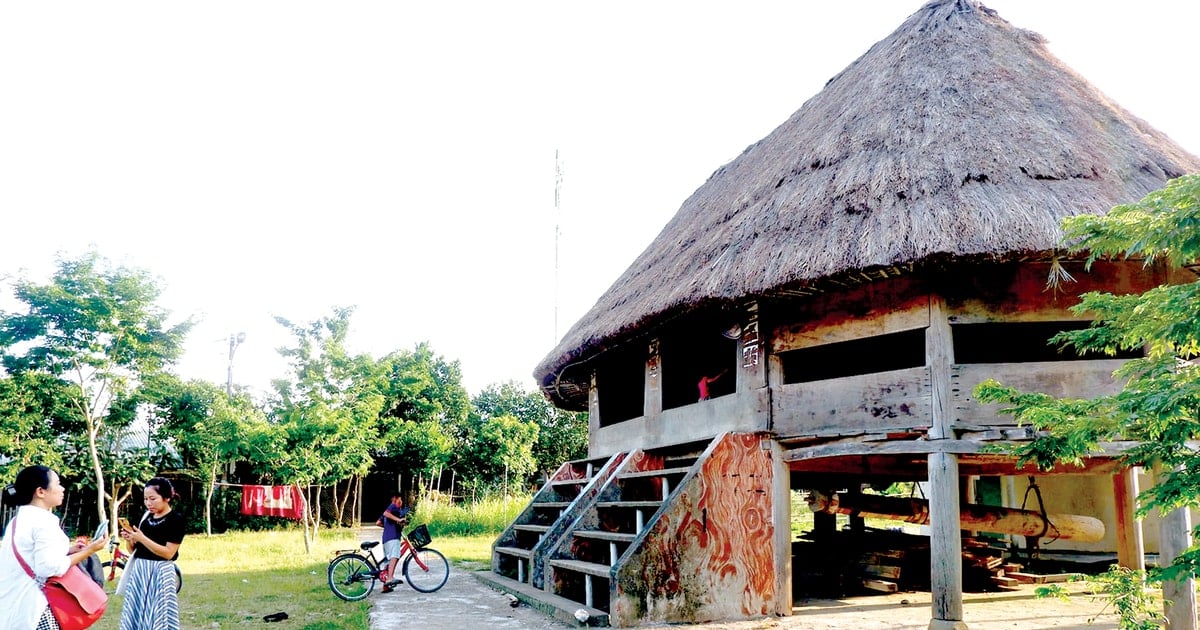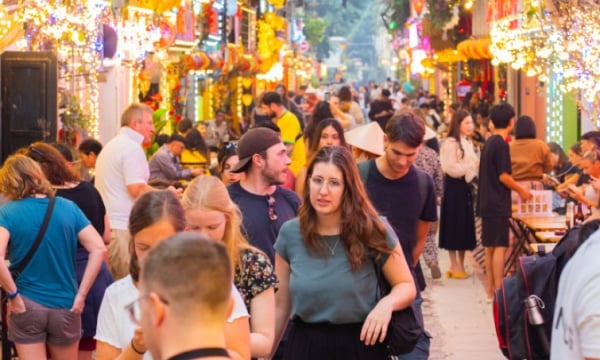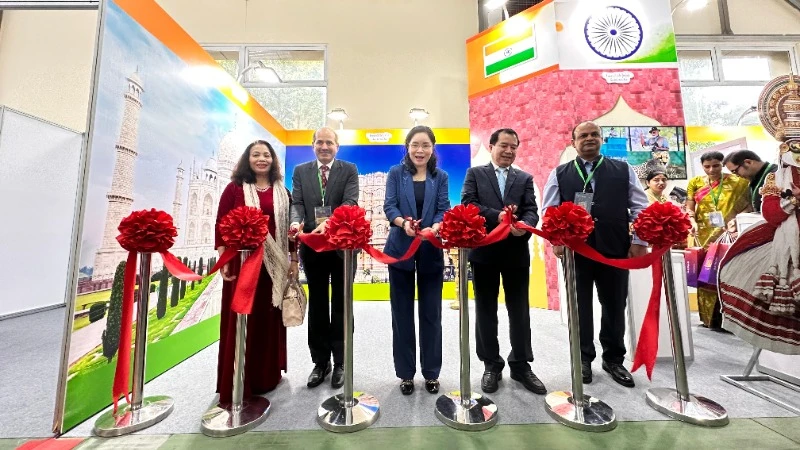Vietnamese tourism does not pay attention to the domestic market, services do not meet demand, so Vietnamese tourists tend to go abroad more, according to experts.
At the conference "Vietnam Tourism 2023: Goals & Recovery" jointly organized by tourism market research company Outbox and Saigontourist Group in September, Ms. Nguyen Anh Thu, research director of Outbox, commented that the recovery speed of the international tourist market is "much slower" than the domestic market.
In 2022, while the inbound market (welcoming international visitors to Vietnam) is still quiet, the domestic market has achieved a recovery level exceeding the 2019 level. In 2019, Vietnam welcomed 85 million domestic visitors, and in 2022 it increased to more than 101 million. In the first 7 months of 2023, the total number of domestic visitors reached 76.5 million, about 11 times higher than international visitors. Meanwhile, in 2019, Vietnam welcomed 18 million international visitors. The target of welcoming international visitors set for 2023 is 8 million, less than 50% of the results in 2019.

Correlation chart of domestic tourist arrivals with total tourist arrivals in Vietnam in the period 2015-2022. Source: National Tourism Administration
Ms. Nguyen Anh Thu said that 18 months ago, domestic tourism was mentioned as a "leveraging tool" to restore the entire tourism industry. Up to now, the domestic market has shown no signs of slowing down and is always on a steady growth path. Ms. Thu raised the issue that Vietnamese tourism businesses need to pay more attention to, take advantage of the domestic market, consider it a large market, and reduce dependence on international visitors.
Outbox CEO Dang Manh Phuoc believes that domestic tourism should be considered an "important market". Vietnam has a huge advantage in domestic tourism with a large population, a high proportion of the middle class and great purchasing power. "If we only consider it as a seasonal market to leverage when needed without a longer-term strategy and proper investment, it would be a waste," said Mr. Phuoc.
Ms. Anh Thu commented that the domestic market always plays an important role in Vietnamese tourism in terms of both visitors and revenue. In the period 2015-2019, the domestic market accounted for 85% of total visitors. Revenue from this market increased steadily over the years, from 158,000 billion VND in 2015 to 334,000 billion VND in 2019, accounting for 43% of total tourism revenue.

Tu Le terraced fields in the flooding season, one of the experiences that attracts domestic tourists. Photo: Dao Viet Hung
In addition to total revenue growth, average revenue growth from each domestic visitor is also showing a strong upward trend, meaning domestic visitors are spending more on tourism products and services.
The domestic market is also a key factor in the sustainable development of the national tourism industry, especially in times of external environmental fluctuations. Evidence is the boom in the domestic market in 2022, which greatly contributed to the recovery of the tourism industry after Covid-19.
Saigontourist Group Deputy General Director Nguyen Dong Hoa said that the reception of domestic tourists in 2023 "decreased somewhat and was uneven" compared to 2022. In some localities that used to be tourist hotspots such as Phu Quoc or Nha Trang, the number of visitors did not meet expectations, even lower than the same period last year. However, some localities recorded positive growth thanks to new expressways, for example Phan Thiet.
According to Mr. Hoa, 2022 is considered a "boom" year for domestic tourism. From those positive numbers, Vietnamese tourism continues to have high expectations this year. However, the economic recession and inadequate tourism infrastructure have caused revenue to fall short of expectations.
"The quality of service not meeting demand is also one of the reasons why Vietnamese tourists tend to travel abroad this year," said Mr. Hoa.
According to a survey on the demand for overseas travel (measured by the level of interest and searches of users on Google Search for air tickets and accommodation) of Southeast Asian tourists in the second quarter, Vietnam is the country with the highest growth rate, equal to 175% compared to the same period before the pandemic. 65% of Vietnamese searches are aimed at destinations in the Southeast Asian region.

Tourists visit the Ho Chi Minh City People's Committee headquarters on April 30. Photo: Quynh Tran
Ms. Thao Ly, 27 years old, a communications employee in Ho Chi Minh City, said that last year, on average, she traveled to a domestic destination like Ha Giang, Da Lat, Phu Quoc, Quy Nhon every two months because "everything from airfare to room rates are cheap". This year, Ms. Ly "only traveled abroad and has not had any domestic trips".
"The cost of traveling from Ho Chi Minh City to Hanoi or Phu Quoc for 5-7 days costs about 7-10 million VND, including airfare and 4-5 star hotel accommodation. After considering, I chose to travel to Thailand for 5 days with a total cost of about 10 million VND. Traveling to some destinations in Asia such as Korea or Taiwan currently has quite attractive prices, spending 10-15 million VND can comfortably travel abroad," said Ms. Ly.
According to the Deputy General Director of Saigontourist Group, to attract domestic tourists, Vietnamese tourism businesses need to improve service quality, create more attractive promotional programs and add new experiences.
Mr. Hoa said that Vietnamese people exploiting Vietnamese tourism have the advantage of "understanding customer needs". For example, Vietnamese tourists care more about and often spend more on food than international tourists. Meanwhile, foreign tourists often look for traditional Vietnamese dishes, which have high cultural value but low cost.
Mr. Nam Nguyen, General Director of Trip.com Vietnam, said that international visitors play an important role in the recovery of the tourism market. However, the core foundation for creating sustainable growth is to "diversify customer sources", especially "take advantage of local tourist sources". In 2024, Trip.com will implement a strategy of "localizing" the content and products sold on the platform, creating closeness to the tastes and approaches of Vietnamese customers.
According to Ms. Anh Thu, to effectively exploit the domestic tourist market, businesses should change their perspective, from a "tool" market to a "customer segment", clarifying the behavioral characteristics, tourism consumption trends, and willingness to pay of the domestic market. More deeply, it is necessary to position sub-segments suitable for each group of products and services in this large customer file.
Ms. Thu said that to encourage domestic tourism, the government and local authorities can intervene in the provision of local tourism services through pricing, marketing and promotion, improving the link between transportation and tourism. For example, in 2019, Thailand stimulated domestic demand by subsidizing people to travel domestically. Each person received 1,500 baht (about 1 million VND) to travel to 55 provinces in the country.
Focusing on the domestic market does not mean choosing to "trade off" another market, but rather "opening up more opportunities to increase total tourism revenue, diversifying markets, and adding more demand for destinations and businesses," said Ms. Thu.
Bich Phuong - Van Khanh
Source link



![[Photo] Opening of the 11th Conference of the 13th Party Central Committee](https://vstatic.vietnam.vn/vietnam/resource/IMAGE/2025/4/10/f9e717b67de343d7b687cb419c0829a2)

![[Photo] April Festival in Can Tho City](https://vstatic.vietnam.vn/vietnam/resource/IMAGE/2025/4/10/bf5ae82870e648fabfbcc93a25b481ea)
![[Photo] Unique folk games at Chuong Village Festival](https://vstatic.vietnam.vn/vietnam/resource/IMAGE/2025/4/10/cff805a06fdd443b9474c017f98075a4)

















![[Photo] Jubilant Opening Ceremony of VITM Hanoi International Tourism Fair](https://vstatic.vietnam.vn/vietnam/resource/IMAGE/2025/4/10/cd3c6162acfd451dae86e479f510fe44)






































































Comment (0)